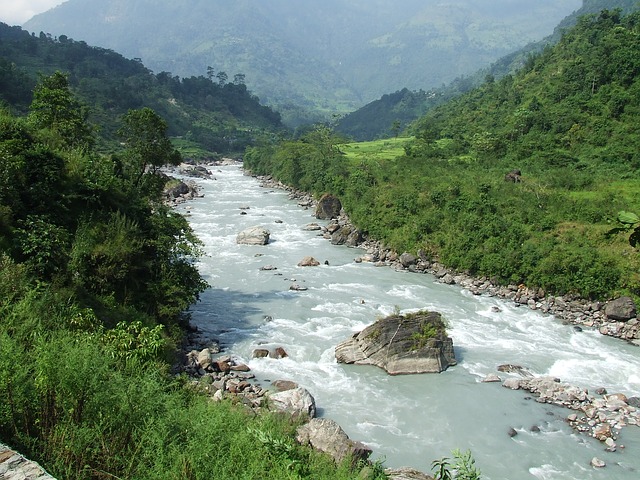Backpacking in Nepal
Despite the fact that Nepal is quite isolated between the Himalayan mountains and China, which is not very friendly to the Nepalese, it is a country that is fully focused on tourism. However, there are two types of tourists to distinguish. On the one hand, there are the rich wannabe adventurers, thousands of whom go to the Himalayas every year to search for their lost ego. And on the other hand the nature-enthusiastic culturally interested and environmentally conscious guests who are interested in the country and its people. Of course, the mountains and trekking are the highlights in Nepal, but in order to experience this, it is not necessary to leave tons of rubbish in the breathtaking mountain world.
The article appears shortly after an earthquake in Nepal has razed many of the visitor highlights to the ground and also paralyzed large parts of the traffic infrastructure. We therefore ask for updates from visitors who were on site after the earthquake.
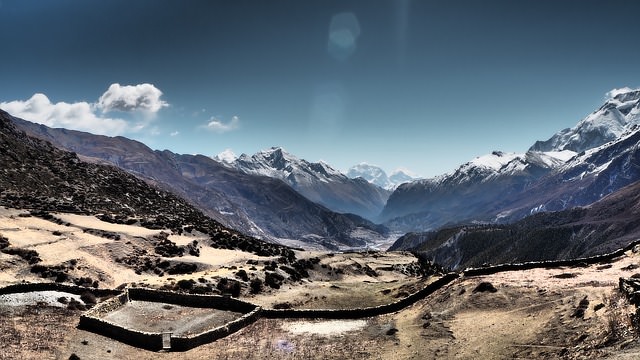
Backpacking in Nepal – Hiking
By the way, the Nepalese government did not attach much importance to the rescue of the wealthy mountaineers after the earthquake to the enthusiasm of the inhabitants. The own people were only secondarily thought of. One can recognize by the fact that Nepal appreciates the tourists (especially the rich ones) very much.
Traveln was not exactly easy for the backpacker in Nepal, because everything is slow and tough, but it worked. But nobody should be in a hurry on a backpacking trip through Nepal anyway. You will always be surrounded by gigantic mountain formations that will take your breath away. But there are also tropical zones like Terai in the Gangetic Plains, which are only 100 meters above sea level. If you want to get high up, you can choose between more than 90 over 7000 meters. But nobody has to be so high to enjoy the majestic mountain world in Nepal.
By the way, you will find ATMs in every bigger city. The backpacker trip is not expensive thanks to the inexpensive cost of living. A simple room or a bed costs between 5 and 10 Euros. There are accommodations for every taste and above all every purse. After the Mount Everest was conquered with the help of the wheezing Sherpas, the bonze has to come back to air in a 5 star spa hotel.
You can get food and tasty local food at every street corner from 2 Euro. Those who manage without imported beer can count on a daily budget of 20 to 30 euros. If you want to stay away from the tourist herds that arrive with organized tours, stay in Kathmandu, where you can still enjoy the local flair.
Culture in Nepal
In Nepal many different tribes live in the mountains, the valleys and the lowlands. All of them are Hindus and Buddhists and have very different traditions. You should therefore exercise restraint on your backpacker trip and respect the centuries-old cultures. This already starts with your clothes. If you appear as an unwashed bum and unshaven hardcore trekker, you’ve already gambled away. You should also never enter one of the Nepalese shrines with shorts and shirts. Shoes off!! That also applies. If you want to go to a Hindu temple, ask for permission. However, you won’t get admission to some of them.
Backpacker Route in Nepal
Nepal is a tourist country. And despite all the wealthy and less wealthy tourists, the country is bitterly poor. Which, of course, does not mean that everyone is poor. Some Cleverlings literally take the money out of every traveller’s pocket. Only where the wealth goes that the hundreds of thousands of tourists who come to Nepal every year leave, nobody knows. Some destinations are totally overcrowded, others are hardly visited.
Those who want to go up to Mount Everest have to queue or have a lot of money. But there are further 90 mountains that are more than 7000 m high. All of them are at least as impressive as Everest. And why stand in the middle of the mountain climber garbage when everything is still quite clean on the mountain next door. What should you have seen? Here are a few suggestions for your Nepal backpacker trip.
Route 1: The classic (15-20 days)
- 3 days in Kathmandu to visit the cosmopolitan ¾ million capital of the country with its partly destroyed temples.
- 1 day visit Swayambhunath in the mountains of Stupa. The place is considered the Mecca of the Newari Buddhists.
- 1 day to get to know Boudnath with the largest stupas in the world. A must for every Buddhist.
- 1 day visiting the Pashupatinath Temple on the Baghmati River, considered one of the most important Hindu temples.
- 1 day royal palace Hanuman Dhoka.
- 2 days relaxing at Lake Phewa. It is not the largest lake of the country but one of the most beautiful.
- 1 day to enjoy the magnificent view of the Himalayas from the Pokhara vantage point.
- 1 day visit Nyatapola temple complex. The magnificent 5-storey building dates from the 18th century.
- 1 day visiting the elephant deity in Surya Vinayak.
- 1 day to visit the Dattatreya temple built from a tree.
- 2 days in Pokhara. Numerous adventure tours start from the third largest city.
Route 2: Backpacker Intensive Trip (up to 40 days and more)
- 3 days in Kathmandu to visit the cosmopolitan ¾ million capital of the country with its partly destroyed temples.
- 1 day visit Swayambhunath in the mountains of Stupa. The place is considered the Mecca of the Newari Buddhists.
- 1 day to get to know Boudnath with the largest stupas in the world. A must for every Buddhist.
- 1 day visiting the Pashupatinath Temple on the Baghmati River, considered one of the most important Hindu temples.
- 1 day Royal Palace Hanuman Dhoka
- 2 days relaxing at the Phewa Lake. It is not the largest lake in the country but one of the most beautiful.
- 1 day enjoy the magnificent view of the Himalayas from the Pokhara vantage point.
- 1 day visit Nyatapola temple complex. The magnificent 5-storey building dates from the 18th century.
- 1 day visiting the elephant deity in Surya Vinayak.
- 1 day to visit the Dattatreya temple complex built from a tree.
- 2 days in Pokhara. Numerous adventure tours start from the third largest city.
- 3-5 days to make the world-famous Annapurna Trekking Trip
- 2 days to discover at least elephants, tigers and more in Chitwan National Park.
- 2 days experience the fascinating sunsets in Daman.
- 2 days cave tour in Parping
Travel times in Nepal
If possible, try to avoid the high season from mid-October to mid-April, because then it can get crowded especially at the most important sights. At this time it gets colder also in the lowlands with the exception of the subtropical regions. This is problematic because heating systems are unknown. More rain awaits you during backpacking in the European summer from June to September. In the so-called monsoon season, however, it doesn’t rain continuously for days on end. It just rains – sometimes heavily – especially on the mountain slopes. In Tibet it is always cold. Sure, given the altitude. The best trekking time is from October to November and February to April.
Backpacker Budget in Nepal
Traveling and living in Nepal is very cheap by European standards. You won’t find any luxury except in the 5 star hotels, but many places are well-kept, even if poverty is present everywhere. Take your time and enjoy the country backpacking. The official currency is the rupee. You can withdraw money from any machine. It’s better to leave traveller’s cheques at home. No one will take them away from you anymore. You have to pay for pretty much everything. Fees are due at almost every halfway tourist highlight. It’s better not to ask yourself where all the money is going The sights have their price, as I said. Before the earthquake, the entrance to Durbar Square, Kathmandu cost around 6 Euro.
The entrance fee to the Garden of Dreams was around 1.5 Euro. For Pashupatinath you have to pay about 7-8 Euro. The birthplace of Buddha in Lumbini cost the same. Trekking also costs. Around 20 to 30 Euro you have to pay alone for the entrance to the Everest National Park. Other small trekking tours cost around 15 Euro so-called TIMS. The best way to travel is by long-distance bus. Some tours may take a while because the country is as big as Germany. In the cities you take the taxi. This costs 3-6 Euro for shorter distances. Cheaper are the bicycle rickshaws. Cheap and a little faster are the three-wheeled Tuk-Tuks.
The cost of living is low in Nepal. A bottle of water – you should always buy bottled water, costs 15 cents. Three times a cola. The local beer costs about 2-3 Euro.
Buses in Nepal
Bus travel is a cheap way to get from A to B in Nepal as a backpacker. Insiders advise against night journeys also with long-distance buses because of the increased accident risk. Take the buses at 7 in the morning and enjoy the country. It is best to buy the ticket one day before departure. The departure often takes place much later than indicated. The route Kathmandu-Pokhara costs about 7 Euro by bus.
Domestic fares in Nepal
You can also fly in Nepal, but it’s not worth it because of the breathtaking scenery. You’d better take the intercity buses during the day and enjoy the overwhelming landscape. If you still want to fly, then take a look at the airlines Nepal yetiairlines.com or Buddha Air or Nepal Cosmic Air for the current fares. You can’t travel by train in Nepal.
Backpacker Accommodation in Nepal
Nepal and the regions of Kathmandu are geared towards tourists of all kinds, and therefore there are accommodations of all kinds for the guests. From simple guesthouses for backpackers to feudal 5 star hotels for the bigwigs, all types of accommodation are available. As a rule, the prices for an overnight stay are quite reasonable, despite the fantastic cultural and geographical spectacle that is offered to you on your backpacking tour. Those who are lucky and arrive out of season will find a small double room for 3 to 4 Euro. Of course, you shouldn’t expect any comfort. But who wants to experience Nepal in their room? Bed is enough.
You can rent a guesthouse room or other accommodation for one month. With a little more comfort they cost between 100 and 200 Euros. Some have WLAN TV included. And you don’t have to use the shared bathroom either. Hotel rooms in the lower category cost from 7 Euro upwards. It’s not a bad deal. You can also look around for Bed & Breakfasts. The prices are similar to the simple hotels. However, you will enjoy more local flair with your hostel parents. An option for backpackers who want to stay a bit longer are furnished apartments. Have a look at the known websites. There are already some offers from 100 Euro per month. Sometimes even cheaper.
Let’s see what Hostelworld has to offer on average. You must always assume that the accommodation prices in Nepal have changed a bit after the earthquake. We ask you for current dates. At Hostelworld a bed in a dorm costs…
- Kathmandu 4 Euro
- Pokhara 5 euro
- Chitwan 15 Euro
Camping in Nepal
Camping in Nepal is of course not a problem. After all, a whole industry lives from trekking trips with tents. Not always it goes thereby into the high mountains. Where unfortunately also camping and a lot of dirt is left behind. At the camping treks you are partly offered everything the backpacker needs to survive. Tent, food, guide, carrier, often everything is included in the trek. Camping wild is such a thing. It’s best to keep your hands off it or ask the locals where you can pitch your tent. You don’t want someone camping in your garden without being asked.
Backpacker Trips & Tips in Nepal
There is a lot to see and experience in Nepal in the different regions, which is otherwise not available on the globe. The names Kathmandu and Tibet alone have a magical appeal for the backpacker’s senses. There the Nanga Parabat, the Mount Evererst and more than 80 other over 7000m lure. You will also meet remote monasteries where you wonder how you could build them on the mountainside? Discover the whole temple complexes for example in Birgunj or experience tigers living freely in the national parks. Venture a detour into the Chitwan National Park or explore the fertile valleys in Pokhara and Kathmandu In Lumbini Buddha was supposedly born 2500 years ago. The holy temple Maya Devi forms the center of the Buddhist culture. And trekking tours start from Nepalgunj.
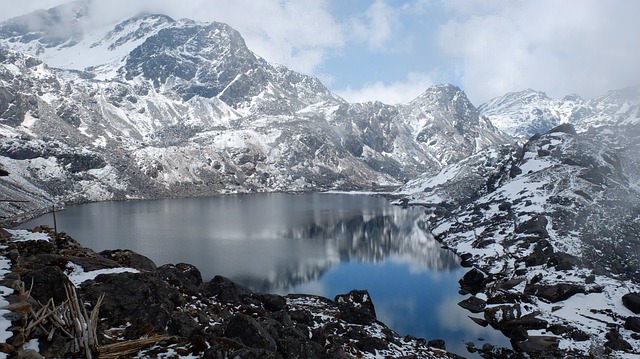
Backpacking in Nepal – Hiking in mountains
Backpacker Highlights in Nepal
If you are not interested in religious tourism, you will come to Nepal because of the large trekking offer. The Annapurna region is the trekking centre of Nepal. There are some more. The Annapurna Trek can take 2 to 3 weeks. It is considered one of the best treks in the world. It goes from Bhulbhule at 800m to Danaqyu at 2200m and then on to Ghyaru at 3730m.
Those who still can make it to the Thorung Pass at 5416 m. Other treks are the Everst Base Camp Trek, the Numbur Cheese Tour, the Island Peak Trek, the Pikey Culture Trail and the Dudh Kunda Culture Trail. You can get to know the indigenous people on the Indigenous Peoples Trail in Ramechhap. Rafting and biking are also offered. It’s also worth to step on the gas at the Full Moon parties and the mystical Trance parties. The Nepal wine Raksi must be tasted with a Tibetan meat ravioli.
Backpacker insider tips in Nepal
The best trekking tours are certainly not always those on which the backpackers cavort in droves. Those who like it lonely and secluded can trek in Kanchenjunga. You can reach the region in three quarters of an hour by plane from Kathmandu. The trip can take up to 40 hours by bus. Another less visited trekking region is Dolpa. Insiders who encounter ethnic mountain villages Flair and few foreigners wanted to travel and trek in Manaslu. Whoever approaches the Upper Mustang Trek wanders through the “Last Forbidden Kingdom” in the Trans-Himalayan region. Everybody knows the Evererst, but hardly anyone the 8.167 m high Mount Dhaulagiri. There is also a barely committed trek of the same name around this one. You will get to know the life of the Tibetan Buddhists on the Tsum Valley Trek.
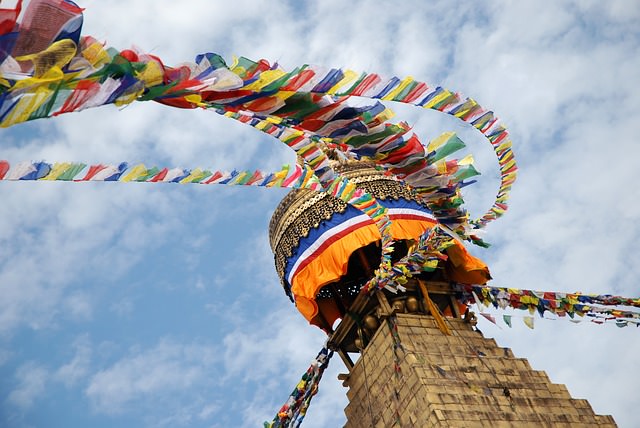
Backpacking in Nepal – Culture
Food & Drinks in Nepal
Basically, Nepalese cuisine has a lot in common with Indian cuisine. But from the lowlands to the mountains there is a great variety due to the cultivation possibilities. The food in Nepal is delicious and inexpensive. If you take advantage of the local offers. You can also buy food in the international fast food chains that you can find here and there, but then why do you go to Nepal? Usually a meal in Kathmandu costs you one Euro. As in India and other Asian countries, street vendors sell delicious local food at super low prices. If you prefer a bit more style, then go to a simple restaurant. There the food costs from 2 Euro. Of course you can also cook yourself, but if it’s worth it, you’ll have to find out for yourself.
Food in Nepal
The national dish daal bhaat (lentils and rice) is available in all lentil colours at a very low price. The common Nepalese eats this dish in variations twice a day. There are already alternatives in the different regions. But from the “Khaanaa chha” – that is a lot of rice with lentil sauce one gets full. You can refine the food with pickled vegetable mixtures. But some of these products are damn hot.
Normally all dishes are eaten with your hands. But be careful! During your backpacking trip in Nepal you should only use your right hand for eating. The left hand is considered unclean. Why? Because it’s long time in? Because for a long time there was no toilet paper in Nepal. Try the little threads called chapatis. In the mountains you will be offered roasted barley flour in the form of dumplings. Meat eaters should try yak meat. A treat are potatoes with bamboo shoots called Aloo Tama. If you go to Tibet, try Momo or Momocha – this is the Tibetan meat ravioli.
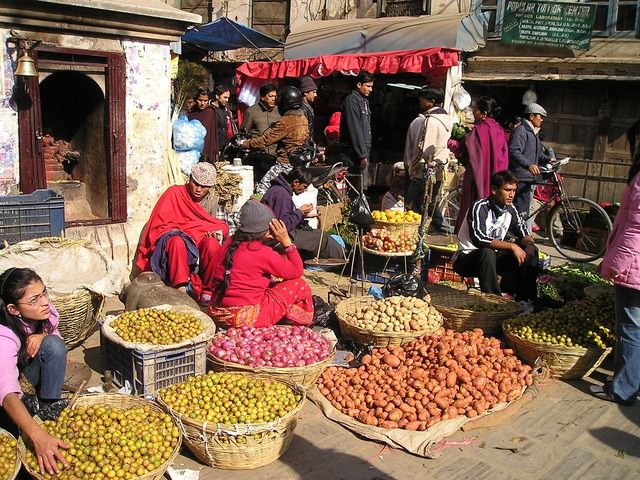
Backpacking in Nepal – Food
Drinks in Nepal
In Nepal a lot of water is drunk. However, you should never drink the glass of water offered to you for dinner. Nepal tap water is anything but clean and certainly not after the earthquake. Make sure you buy industrially bottled water or drink the popular sweet tea with milk. Drinking in Nepal of course also. Especially the male Hindus like to tap their pears.
The Buddhists in the mountain regions also do not know any prohibitions. With them also the women like to take one over their thirst. Normally the so-called chhang is tilted. This is a fermented cereal porridge made of rice, barley, millet, corn or a mix of all. It is also used to make high-proof alcohol. This is called Rakshi. You will also find local beer, which is still quite ok. Imported beer is also available in the tourist resorts.
Backpacker Visa and Vaccination in Nepal
Even as a German you won’t get into Nepal without valid identity papers. The documents you need to experience backpacking in Nepal, Tibet and Kathmandu are listed below. For security reasons, the Federal Foreign Office recommends not to visit southeastern Terai. To enter the country as a German citizen, you will need the following documents:
- Passport: Yes
- Provisional passport: Yes
- Identity card: No
- Temporary identity card: No
- Children’s passport: Yes
- Still valid child ID card according to old model: No
All travel documents must be valid for six months. Each child needs their own travel document. You will receive your visa when you enter Nepal or at the airport in Kathmandu. Calculated for one month 35 Euro costs.
Medical information
The vaccination protection should always be complete and up to date when travelling to Nepal. It is best to stick to the standard vaccinations of the Robert Koch Institute. In Nepal there are dengue and malaria up to 2000 m. Tuberculosis, HIV and rabies are common. Japanese encephalitis and bird flu are also known. Backpackers often have major problems with altitude sickness.

